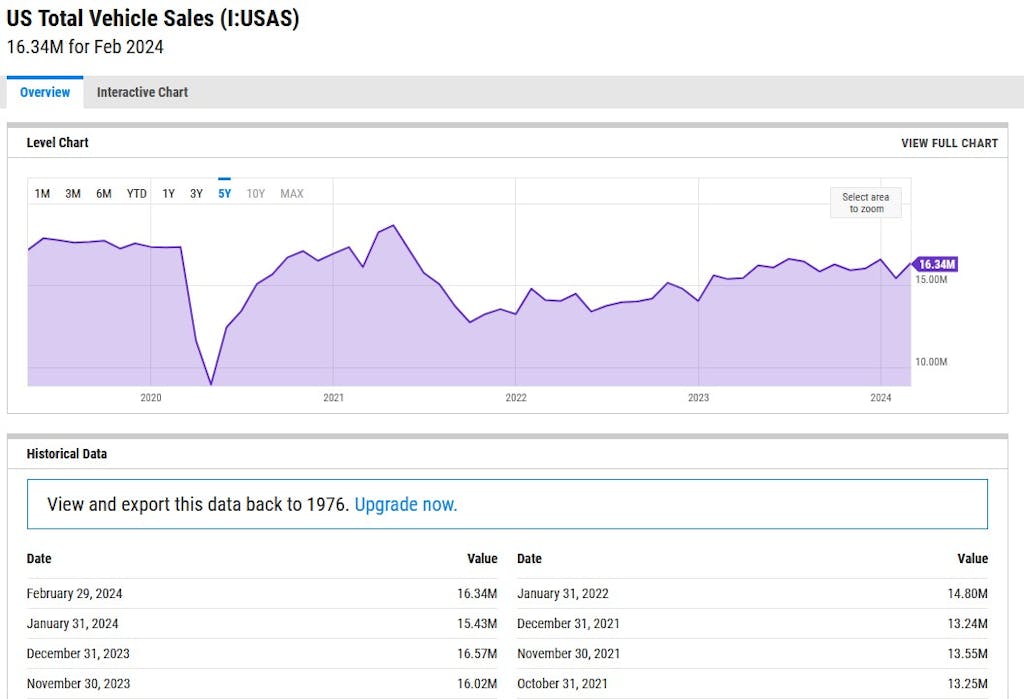Current Affairs
April 2, 2024
U.S. Auto Sales
April 1, 2024
March Propylene Settles Up 3c/lb
Chemical Grade propylene settles up 3c/lb to $0.565/lb . . .

March 26, 2024
Durable Goods Rise
Durable Goods Orders Rebound In Feb From January Collapse, Defense Spending Slides
by Tyler Durden
Tuesday, Mar 26, 2024 – 08:38 AM
After crashing in January (driven by the collapse in Boeing orders), durable goods orders (preliminary) for February rose 1.4% MoM (better than the +1.0% MoM exp), and notably swinging from a downwardly revised 6.9% MoM plunge in January (from -6.2%)…

Source: Bloomberg
That dragged the headline orders up 4.6% YoY. Ex-Transports also beat, rising 0.5% MoM (vs +0.4% exp) and up 1.3% YoY.
Non-defense aircraft orders jumped 24.6% MoM as it seems people are ordering Boeings again? Defense spending tumbled 12.7% MoM…
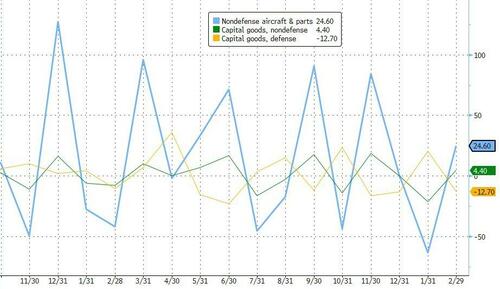
Source: Bloomberg
Computer & related products saw another big MoM rise as perhaps this is the AI cycle showing up in the data…
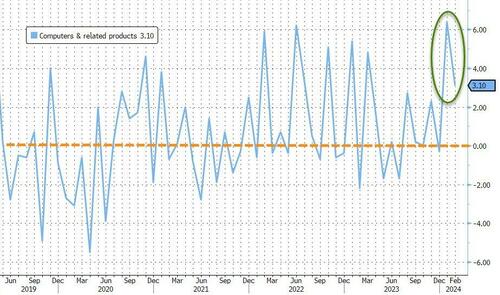
Source: Bloomberg
On the bright side, core capital goods shipments, a figure that is used to help calculate equipment investment in the government’s gross domestic product report, continued its strong bounce back from YoY contraction in December. However, on a seasonally-adjusted basis, core capital goods shipments fell 0.4% MoM
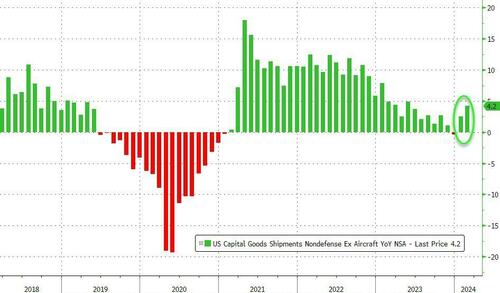
Source: Bloomberg
The YoY rebound is not exactly a signal that portends rate cuts!
March 19, 2024
Housing Starts
Housing Starts And Permits Surged In February (Despite Plunging Rate-Cut Odds)
by Tyler Durden
Tuesday, Mar 19, 2024 – 08:44 AM
Housing Starts and Permits rebounded firmly in February from an ugly January.
Starts soared 10.7% MoM (+8.2% exp) recovering some of the 12.3% MoM decline in January and Permits jumped 1.9% (+0.5% exp) from the upwardly revised -0.3% MoM decline in January…
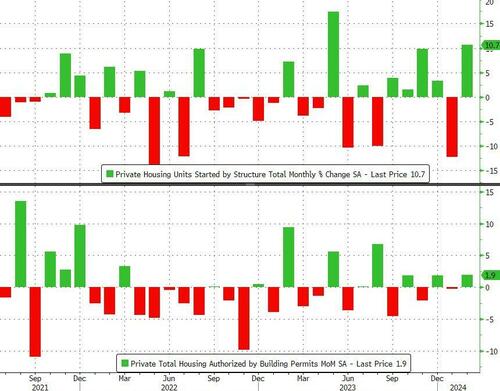
Source: Bloomberg
That was the biggest monthly jump in Starts since May and biggest permits rise since August.
With weather being blamed for January’s decline, February seems like a return to post-COVID lower norms…
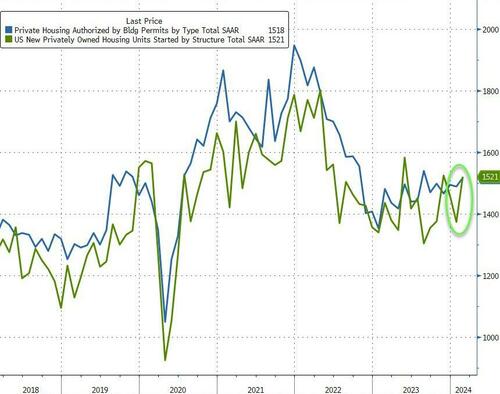
Source: Bloomberg
Under the hood, rental unit housing permits outpaced single-family units
- Single-Family: up 1.0% to 1.031MM from 1.021MM
- Rentals: up 2.4% to 429K from a four year low of 419K

On the Housing Starts side, single-family units rose more (but both saw signifiant rises):
- Single-Family: up 11.6% to 1.129MM, highest since April 2022, from 1.012MM
- Rentals: up 8.6% to 377K from 347K

All good news for the meager supply out there. The question is – with rate-cut odds plummeting, has homebuilder confidence, which recently spiked back above 50, got too far over their skis on expectations of The Fed saving the day.
If they build it, will home buyers come?
March 18, 2024
American Energy Overview
America’s fossil fuel industry is booming.
Indeed, while clean energy policies (or, perhaps, a lack thereof) are debated ahead of November’s election, one quiet fact has gone relatively under the radar: no country in the history of our planet has pulled crude oil out of the ground at the pace of the United States over the last 6 years.
Data released by the US Energy Information Administration (EIA) on Monday finds that the US produced the equivalent of 12.9 million barrels of crude oil and condensate per day last year, 28% more than the world’s previous top producer, Russia, and 33% more than even the oil-rich Kingdom of Saudi Arabia.

Reversing the flow
The modern petroleum industry can trace its roots — or wells — back to the 1850s when Edwin Drake dug a ~70 foot oil hole in Pennsylvania and started pumping up to 20 barrels a day of what would come to be known as black gold. But, despite getting a head start on much of the rest of the world, the US was a tiny player in global oil for much of the latter half of the 20th century.
Indeed, were you to transport someone from the oil-importing heyday of the year 2000 to the present day, they’d scarcely believe that the US had become a net exporter of oil (chart here), let alone become the dominant force in a market that — despite the best efforts of renewable scientists — remains the most important global energy source.
Frack to the future
The shale revolution is often credited with much of the progress in America’s newfound oil boom, as hydraulic fracturing (or fracking) unlocked a wave of previously inaccessible, or at least uneconomical, oil and gas reserves. Fracking involves forcing liquid — usually water mixed with sand and chemicals — into fissures in shale rock, cracking and expanding the gaps, allowing the once-trapped oil and gas to find its way to the surface.
As fracking got more efficient, it wasn’t just the crude oil industry that benefited: America’s natural gas production has also exploded over the last 15 years.

Gassed up
Oil and natural gas now join the ranks of heavy machinery, semiconductor chips, and cultural exports like TV & movies, as one of America’s most important trading markets. In December 2023, the US exported ~400bn cubic feet more natural gas than it imported, a dramatic shift from a decade earlier. Driving much of the boom is America’s liquefied natural gas (LNG) export industry, which — as recently as 2015 — basically didn’t exist.
By liquefying the gas, at a frosty -260° Fahrenheit, shipping and storage becomes a lot easier, with the volume of natural gas in its liquid state roughly 1/600th of the volume in its gaseous state — enabling America’s newfound fracking success to be shipped all over the world.
Upheaval in energy markets, particularly after Russia’s invasion of Ukraine, further boosted demand for American LNG. Indeed, over the past 2 years more than 60% of US LNG exports have found their way to Europe, where buyers have been looking to replace lost supply from Russia. The overall result? From what was pretty much a standing start at the beginning of 2016, America’s LNG industry is now shattering records, with the US becoming the largest exporter of LNG in 2023, unseating Australia and Qatar.
Rigged
One of the most striking things about America’s ongoing fossil fuel boom is that the industry has learned to do more with less.

To get a sense of whether US oil production was likely to rise or fall, you used to be able to look at the number of drilling rigs — the towering steel structures that dig wells and adorn oil-rich regions like the Permian basin in Texas. However, despite the production upswing, the number of crude oil rigs has actually fallen, to about one-third of what it was a decade ago. Advancements in fracking, as well as new “horizontal drilling” techniques — that can spread more than 3 miles underground in one direction — has enabled drillers to increase production without the need for additional rigs.
Independence decade
The “shale revolution” has not only dramatically transformed global oil markets — and made a lot of people a lot of money — it has also shifted the sands that underlie global power structures. Although it would be a gross oversimplification to suggest “America doesn’t need anyone else’s oil or gas”, the fact remains that a thriving energy sector gives American leaders a stronger hand when negotiating on the world stage, as well as the ability to step in for allies when supply from volatile regimes is lost or blocked.
